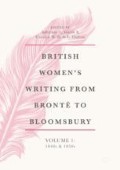Abstract
This chapter discusses sadomasochism and female identity in Charlotte Brontë’s Villette (1853), showing that the proto-feminist and masochist sides of Brontë’s heroines are not mutually exclusive. Triangulating Villette’s romantic subversiveness with 1850s calls for marriage reform and Brontë’s engagement with Georg Wilhelm Friedrich Hegel’s ‘The Master/Slave Dialectic,’ Boucher argues that Brontë reframes female submissiveness and self-sacrifice as a subversion, rather than reification, of patriarchal structures. Gender roles thereby become sources of power to Lucy Snowe, and Villette’s portrayal of consensual sadomasochistic relationships depicts the complexity of an individual woman’s desires, and the very novelty and complexity of those desires creates a proto-feminist space inside a greater culture of submission and (self-)victimization.
Access this chapter
Tax calculation will be finalised at checkout
Purchases are for personal use only
Works Cited
Brontë, Charlotte. Villette. 1853. Ed. Mark Lilly. London: Penguin, 1979.
Clarke, Micael M. ‘Brontë’s Jane Eyre and the Grimms’ Cinderella.’ Studies in English Literature, 1500–1900 40.4 (Autumn 2000): 695–710.
Davies, Stevie. ‘“Three Distinct and Unconnected Tales”: The Professor, Agnes Grey and Wuthering Heights.’ In The Cambridge Companion to the Brontës. Ed. Heather Glen. Cambridge: Cambridge University Press, 2002. 72–98.
Dobbins, Meg. ‘“What Did You Cut it off for, Then?”: Self-Harming Heroines in Villette, The Mill on the Floss, and Tess of the D’Urbervilles.’ Nineteenth-Century Gender Studies 13.1 (Spring 2017). http://www.ncgsjournal.com/issue131/issue131.htm. Accessed 21 August 2017.
Dutta, Sangeeta. ‘Charlotte Brontë and the Woman Question.’ Economic and Political Weekly 26.40 (5 October 1991): 2311–16.
Felski, Rita. ‘Redescriptions of Female Masochism.’ Minnesota Review 63/64 (2005): 127–39.
Gilbert, Sandra M. and Susan Gubar. The Madwoman in the Attic: The Woman Writer and the Nineteenth-Century Literary Imagination. 2nd edition. New Haven: Yale University Press, 1984.
Halttunen, Karen. ‘Humanitarianism and the Pornography of Pain in Anglo-American Culture.’ The American Historical Review 100.2 (April 1995): 303–34.
Harris, Errol E. The Spirit of Hegel. Atlantic Highlands, NJ: Humanities Press, 1993.
Hegel, Georg W. F. The Phenomenology of Spirit. 1807. Trans. J. B. Baillie. 1910. North Charleston, South Carolina: Pantianos Classics, 2016.
Jarvis, Claire. Exquisite Masochism: Marriage, Sex and the Novel Form. Baltimore: Johns Hopkins University Press, 2016.
Killeen, Jarlath. Gothic Literature 1825–1914. Cardiff: University of Wales Press, 2009.
Leckie, Barbara. Culture and Adultery: The Novel, the Newspaper, and the Law, 1857–1914. Philadelphia: University of Pennsylvania Press, 1999.
Martineau, Harriet. Review of Villette, by Currer Bell [Charlotte Brontë], Daily News 2092 (3 February 1853): 2.
‘masochism, n.’ OED Online. Oxford: Oxford University Press, June 2017. Accessed 10 July 2017.
Maynard, John. Charlotte Brontë and Sexuality. Cambridge: Cambridge University Press, 1984.
‘sadism, n.’ OED Online. Oxford: Oxford University Press, June 2017. Accessed 10 July 2017.
‘sadomasochism, n.’ OED Online. Oxford: Oxford University Press, June 2017. Accessed 10 July 2017.
Sinnerbrink, Robert. Understanding Hegelianism. Stocksfield, Northumberland: Acumen, 2007.
Surridge, Lisa Anne. Bleak Houses: Marital Violence in Victorian Fiction. Athens, OH: Ohio University Press, 2005.
Warhol, Robyn R. ‘Double Gender, Double Genre in Jane Eyre and Villette.’ Studies in English Literature, 1500–1900 36.4 (Autumn 1996): 857–75.
Weinberg, Jill D. Consensual Violence: Sex, Sports, and the Politics of Injury. Oakland: University of California Press, 2016.
Wein, Toni. ‘Gothic Desire in Charlotte Brontë’s Villette.’ Studies in English Literature, 1500–1900 39.4 (Autumn 1999): 733–46.
Author information
Authors and Affiliations
Corresponding author
Editor information
Editors and Affiliations
Rights and permissions
Copyright information
© 2018 The Author(s)
About this chapter
Cite this chapter
Boucher, A. (2018). ‘There never was a mistress whose rule was milder’: Sadomasochism and Female Identity in Charlotte Brontë’s Villette. In: Gavin, A., de la L. Oulton, C. (eds) British Women's Writing from Brontë to Bloomsbury, Volume 1. British Women’s Writing from Brontë to Bloomsbury, 1840-1940, vol 1. Palgrave Macmillan, Cham. https://doi.org/10.1007/978-3-319-78226-3_13
Download citation
DOI: https://doi.org/10.1007/978-3-319-78226-3_13
Published:
Publisher Name: Palgrave Macmillan, Cham
Print ISBN: 978-3-319-78225-6
Online ISBN: 978-3-319-78226-3
eBook Packages: Literature, Cultural and Media StudiesLiterature, Cultural and Media Studies (R0)

